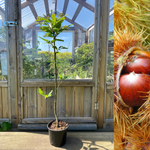Subscribe and save 10%!

Sweet Chestnut Tree 100-125 cm (Castanea sativa)
396 SEK
Unit price perExpected delivery date: 20 December to 27 December.
Applies to orders within Sweden. For other countries - see our delivery terms .
Low in stock
Share
396 SEK
Unit price per1 Sweet Chestnut Tree: 4 years old - current height: 100-125 cm
Note. that trees ordered during the winter months lack foliage.
True chestnuts are self-pollinating - only 1 tree is needed for fruiting.
Common names : Sweet Chestnut, Spanish Chestnut, Real Chestnut, Edible Chestnut
Scientific name : Castanea sativa
Family : Fagaceae
Plant history & use:
Genuine chestnuts have existed in European history for several thousand years. From Roman times it began to spread to the more northern parts of Europe - then often cultivated by monks in monastery gardens.
It is the chestnut brown shiny nuts that are consumed. Nuts are nutritious and have historically even competed with today's most common grains. It was then a flour ground from the chestnuts that was used abundantly - possible thanks to the nuts' rich content of starch, something that is otherwise unusual among nuts.
A more modern widespread way of enjoying the nuts is to roast them together with butter and salt, this is common both around the Mediterranean region and in England (with or without butter). Roasted nuts have a flavor reminiscent of sweet potatoes.
The tree has a beautiful and majestic growth like the oak. However, the real chestnut grows faster than the oak.
In their natural environment, down in southern Europe, the trees can live for over 2000 years.
Cultivation :
Thrives best in a warm and wind-protected location in a sunny location. Grow in well-drained, loamy soil. Feel free to mix grass clippings, compost or stable manure into the top soil layer.
Thrives in slightly acidic soil - optimal pH value is between 4.5-6.
Does not thrive in particularly wet soils.
Water abundantly the first years of establishment.
The tree usually yields after 3-5 years. The nuts are usually ready to harvest around Sep-Oct.
Properties :
Age: Perennial
Plant position: sun
Height: 20-35 m
Growing zone: 1-2
Harvest age: 3-5 years
- Choosing a selection results in a full page refresh.
- Opens in a new window.












